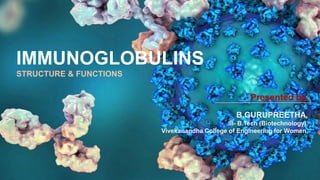
IMMUNOGLOBULINS
- 1. Tips and tools for creating and presenting wide format slides IMMUNOGLOBULINS STRUCTURE & FUNCTIONS Presented by, B.GURUPREETHA, III- B.Tech (Biotechnology), Vivekanandha College of Engineering for Women.
- 3. Definition Glycoprotein molecules that are produced by plasma cells in response to an immunogen and which function as antibodies. Y-shaped protein used by the immune system to identify and neutralize foreign objects such as pathogenic bacteria and viruses. The immunoglobulins derive their name from the finding that they migrate with globular proteins when antibody-containing serum is placed in an electrical field.
- 4. Background In 1890, von Behring and Kitasato Found a agent in the blood that could neutralize diphtheria toxin. In 1939, Tiselius and Kabat used electrophoresis to separate immunized serum albumin alpha-globulin beta-globulin gamma-globulin fractions
- 5. Contd., Absorption of the serum against the antigen yielding the terms gamma globulin, immunoglobulin (Ig), and IgG.
- 6. Contd., Sizing columns were then used to separate immunoglobulins into those that were “heavy” (IgM), “regular” (IgA, IgE, IgD, IgG), and “light” (light chain dimers).
- 7. Role of different immunoglobulin classes IgG: Protects the body fluids IgA: Protects the body surfaces IgM: Protects the blood stream IgE: Mediates type I hypersensitivity IgD: Role not known
- 9. Contd., 1. Heavy and Light Chains All immunoglobulins have a four chain structure as their basic unit. They are composed of two identical light chains (23kD) and two identical heavy chains (50-70kD)
- 10. Contd., 2.Hinge regions: This is the region at which the arms of the antibody molecule forms a Y. It is called the hinge region because there is a some flexibility in the molecule at this point.
- 11. Contd., 3. Disulfide bonds i) Inter-chain disulfide bonds - The heavy and light chains and the two heavy chains are held together ii) Intra-chain disulfide binds - Within each of the polypeptide chains there are also intra-chain disulfide bonds.
- 12. Contd., 4. Variable (V) and Constant (C) Regions Two regions based on variability in the amino acid sequences 1. Light Chain - VL (110 amino acids) and CL (110 amino acids) 2. Heavy Chain - VH (110 amino acids) and CH (330-440 amino acids)
- 13. Contd., 5. Domains Folded globular regions containing intra-chain disulfide bond are called domains. i. Light Chain Domains - VL and CL ii. Heavy Chain Domains - VH, CH1 - CH3 (or CH4)
- 14. Contd., 6. Oligosaccharides Carbohydrates are attached to the CH2 domain in most immunoglobulins. However, in some cases carbohydrates may also be attached at other locations.
- 15. Overall diagram
- 16. Structure of the variable region A. Hypervariable (HVR) or complementarity determining regions (CDR) CDR is the antibody combining site Antibodies with different specificities (i.e. different combining sites) have different complementarity determining regions while antibodies of the exact same specificity have identical complementarity determining regions.
- 17. Contd., B. Framework regions The regions between the complementarity determining regions in the variable region are called the framework regions This regions can be divided into groups and subgroups. These represent the products of different variable region genes.
- 18. Contd.,
- 19. IMMUNOGLOBULIN FRAGMENTS Immunoglobulin fragments produced by proteolytic digestion have proven very useful in elucidating structure/function relationships in immunoglobulins
- 20. Contd., A. Fab This results in the formation of two identical fragments that contain the light chain and the VH and CH1 domains of the heavy chain. Antigen binding - These fragments were called the Fab fragments because they contained the antigen binding sites of the antibody. The combining site of the antibody is created by both VH and VL. An antibody is able to bind a particular antigenic determinant because it has a particular combination of VH and VL.
- 21. Contd., B. Fc This fragment was called Fc because it was easily crystallized. Effector functions - The effector functions of immunoglobulins are mediated by this part of the molecule. Different functions are mediated by the different domains in this fragment.
- 22. Contd., C. F(ab')2 This fragment was called F(ab')2 because it is divalent. The Fc region of the molecule is digested into small peptides by pepsin. The F(ab')2 binds antigen but it does not mediate the effector functions of antibodies.
- 23. Functions Ag binding Can result in protection Valence Effector functions (Usually require Ag binding) Fixation of complement Binding to various cells
- 24. Antigen binding
- 26. Summary
- 27. References: Diane F. Jelinek et al. Middleton’s 8th Edition Abbas 9th Edition. Schroeder, Harry & Cavacini, Lisa. (2010). Structure and Function of Immunoglobulins. The Journal of allergy and clinical immunology. 125. S41-52. 10.1016/j.jaci.2009.09.046. Peter, Spaeth. (1999). Structure and Function of Immunoglobulins. Sepsis. 3. 197. 10.1023/A:1009899803032. J Allergy Clin Immunol. 2010 Feb; 125(2 0 2): S41–S52. doi: 10.1016/j.jaci.2009.09.046
- 28. Thank you!